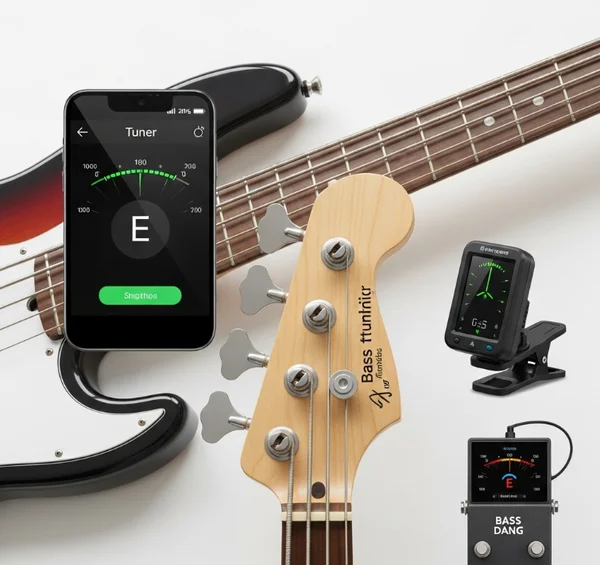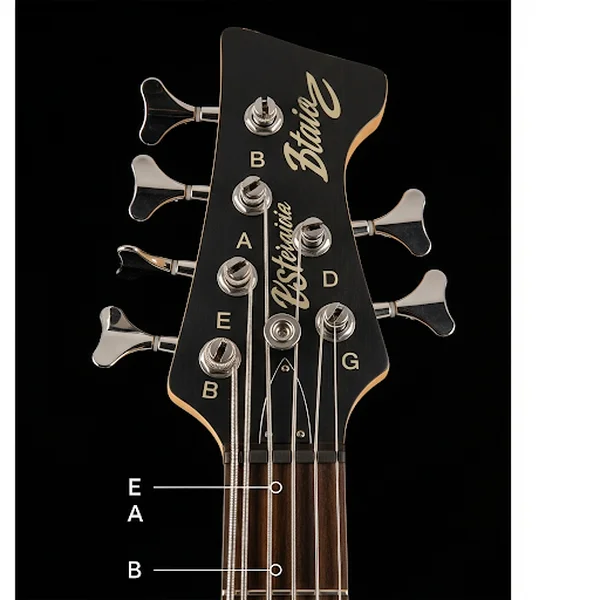Bass Guitar Tuning: Standard EADG & BEADG Guide
Mastering your bass sound starts with perfect bass tuning. What's the easiest way to tune a bass? This comprehensive guide will walk you through standard bass guitar tuning for both 4-string (EADG) and 5-string (BEADG) basses, ensuring your instrument is always ready to lay down that solid groove. We'll also explore how a reliable bass guitar tuner, especially an online bass tuner, can make the process effortless.
Why Proper Bass Tuning is Crucial for Your Groove
Why is precise bass tuning so important? An out-of-tune bass can make an entire band sound off, muddying the low end and disrupting the harmonic foundation. Whether you're practicing at home, jamming with friends, or performing on stage, ensuring your bass is perfectly tuned is the first step to a great performance. Proper tuning allows your bass strings to resonate correctly, producing a clear and powerful sound. This guide focuses on achieving standard bass tuning, the cornerstone for most musical styles.
What You Need for Accurate Bass Tuning
Before you dive into how to tune bass guitar, let's gather the essentials. How do I know if my bass is in tune? You'll need a reliable tuner.
Choosing Your Bass Tuner: Online, Clip-on, or Pedal?
There are several types of bass guitar tuner options available:
-
Online Tuners: These utilize your device's microphone. An online instrument tuner offers incredible convenience as it's accessible anywhere with an internet connection, requires no extra hardware, and provides instant visual feedback for accurate tuning.
-
Clip-on Tuners: These attach to the headstock and sense vibrations.
-
Pedal Tuners: Popular for live performances, these integrate into your effects chain.

For ease of use and accessibility, especially for beginners, a good microphone tuner found online is an excellent starting point.
Understanding Your Bass Guitar Strings and Tuning Pegs
Familiarize yourself with your instrument.
- Bass Strings: On a standard 4-string bass, the thickest string (closest to you when holding the bass) is the lowest pitch, and they get progressively thinner and higher in pitch.
- Tuning Pegs: Each string is connected to a tuning peg (or machine head) on the headstock. Turning a peg tightens or loosens the string, changing its pitch. Typically, turning a peg counter-clockwise lowers the pitch, and clockwise raises it, but always observe your tuner.
How to Tune a 4-String Bass Guitar (Standard EADG Tuning)
The most common tuning for a 4-string bass is E-A-D-G. This is your standard bass tuning. Let's go string by string. What notes should a standard 4-string bass be tuned to?

Step 1: Tuning the E String (Lowest and Thickest)
This is your 4th string. Pluck the open string and watch your bass guitar tuner. Adjust the corresponding tuning peg until the tuner indicates the note E. Many find it helpful to tune up to the note from a slightly flat pitch for better string tension stability.
Step 2: Tuning the A String
This is your 3rd string. Pluck it and adjust its tuning peg until your tuner shows A. This e a d g tuning sequence is fundamental.
Step 3: Tuning the D String
This is your 2nd string. Pluck and tune it to D. As you proceed, you might need to make minor re-adjustments to previously tuned bass strings as changing tension on one string can slightly affect others.
Step 4: Tuning the G String (Highest and Thinnest)
This is your 1st string. Pluck it and tune to G. Congratulations, you've achieved standard e a d g tuning!
Tips for Precise 4-String Bass Tuning with an Online Tuner
When using an online bass tuner, pluck the string firmly but not too aggressively. Let the note sustain. Watch the visual feedback to ensure the pitch is dead center.
How to Tune a 5-String Bass Guitar (Standard BEADG Tuning)
For those with a 5-string bass, the standard tuning adds a lower string: B-E-A-D-G. This is a common 5 string bass tuning.

Understanding the Low B String on a 5-String Bass
The low B string adds significant depth to your sound. It's the thickest string and requires careful bass tuning to avoid floppiness or fret buzz.
Step-by-Step Guide to BEADG Tuning
- B String (5th string, thickest): Tune this to B.
- E String (4th string): Tune to E.
- A String (3rd string): Tune to A.
- D String (2nd string): Tune to D.
- G String (1st string, thinnest): Tune to G. This b e a d g tuning extends your range significantly.
Common Challenges When Tuning a 5-String Bass
The low B string can sometimes be trickier for tuners to pick up cleanly due to its low frequency. Ensure a clear pluck and minimal background noise. Using a quality instrument tuner helps immensely.
Pro Tips for Using an Online Bass Tuner
To get the most out of your online tuning device for bass tuning:
Minimizing Background Noise for Accurate Readings
An online bass tuner uses your microphone, so a quiet environment is best. If there's unavoidable noise, try to position your device's microphone closer to your bass. This helps achieve accurate tuning.
Plucking Technique for a Clear Signal
Use a consistent plucking or picking technique. Pluck the open string clearly and let it ring out. Avoid hitting other strings or creating excessive fret noise. A clean sound helps the microphone tuner detect the pitch correctly.
Understanding the Visual Feedback on Our Tuner
Our online tuner provides clear visual cues. Typically, a needle or indicator will show if the note is flat (too low), sharp (too high), or perfectly in tune. Aim for the indicator to be centered.

Keep Your Bass in Tune, Keep the Rhythm Strong
Regular and accurate bass tuning is a fundamental skill for any bassist. Whether you prefer standard e a d g tuning for your 4-string or b e a d g tuning for your 5-string, a reliable bass guitar tuner is your best friend. We encourage you to try our online bass tuner for a quick, easy, and accurate way to keep your instrument sounding its best.
Your Bass Tuning Questions Answered
What notes should a standard 4-string bass be tuned to?
A standard 4-string bass is tuned to E-A-D-G, starting from the thickest (lowest pitch) string to the thinnest (highest pitch) string. This is the most common standard bass tuning.
How often should I tune my bass guitar?
You should check your bass tuning every time you pick up your instrument to play. Temperature changes, humidity, and even vigorous playing can cause bass strings to go out of tune. Many musicians tune before each practice session and multiple times during a performance.
Can I use a guitar tuner for my bass?
Yes, most modern chromatic tuners, including many guitar tuners and our versatile online tuner, can be used for bass guitar tuning. Ensure the tuner can recognize the lower frequencies of bass strings, especially the low B on a 5-string.
Why does my bass guitar go out of tune so quickly?
Several factors can cause this:
- New strings: New bass strings need time to stretch and settle.
- Tuning pegs: Worn or loose tuning pegs might not hold tension well.
- Nut issues: If the string slots in the nut are too tight or poorly cut.
- Bridge problems: Less common, but issues with the bridge can affect tuning stability.
- Aggressive playing style: Heavy bending or plucking can detune strings faster.
- Environmental changes: Fluctuations in temperature and humidity.
Is it hard to tune a 5-string bass?
Not significantly harder than a 4-string, but the low B string can sometimes present a slight challenge for some tuners due to its very low pitch. The process for 5 string bass tuning is the same, just with an extra string. Using a good quality bass guitar tuner, like our easy-to-use online tuner, will make it straightforward.